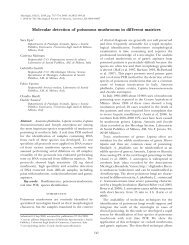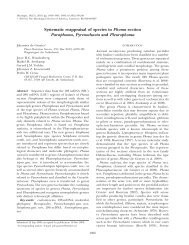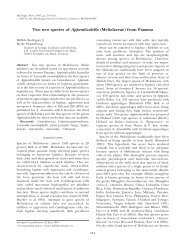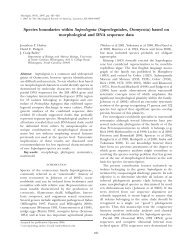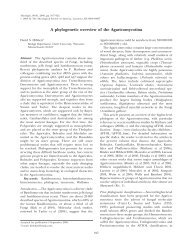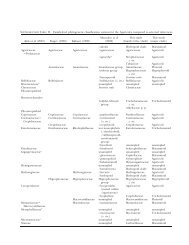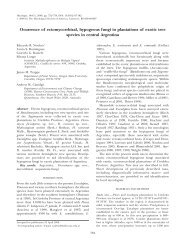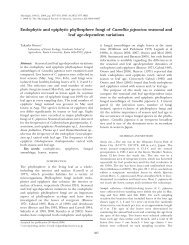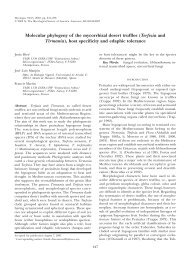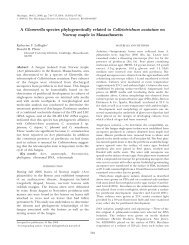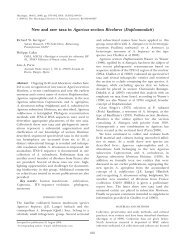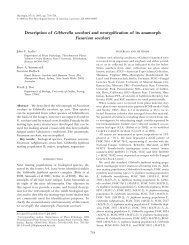Short title: Revision of Morchella taxonomy Taxonomic ... - Mycologia
Short title: Revision of Morchella taxonomy Taxonomic ... - Mycologia
Short title: Revision of Morchella taxonomy Taxonomic ... - Mycologia
You also want an ePaper? Increase the reach of your titles
YUMPU automatically turns print PDFs into web optimized ePapers that Google loves.
Washington.<br />
Comments. <strong>Morchella</strong> importuna corresponds to phylogenetic species Mel-10 in<br />
O'Donnell et al. (2010). The species is distinguished from other morels in the M. elata Clade on<br />
the basis <strong>of</strong> its regularly laddered, vertically oriented pits and ridges, combined with its urban<br />
habitat in landscaping areas, planters, woodchip beds and gardens, primarily in western North<br />
America. One <strong>of</strong> us (Volk) collected morels matching the morphology <strong>of</strong> M. importuna in a<br />
woodchip bed on the campus <strong>of</strong> the University <strong>of</strong> Wisconsin at La Crosse in 1999. <strong>Morchella</strong><br />
hotsonii Snyder (so far known only from the 1935 type collection) is similar and also apparently<br />
appeared in woodchip beds in the Pacific Northwest, although it differs morphologically by<br />
having finely tomentose surfaces (SUPPLEMENTARY MATERIALS, Type studies, for further<br />
information). <strong>Morchella</strong> importuna was treated and illustrated erroneously in Kuo (2005) as<br />
conspecific with the "Classic North American Black Morel"; the top-middle, top-right and<br />
bottom-middle photos on p 179 actually represent M. importuna.<br />
<strong>Morchella</strong> snyderi M. Kuo & Methven, sp. nov. FIG. 16<br />
MycoBank MB 563959<br />
Ascomata 60–140 mm alta; capitulum conicum; costae pallidae, brunnescens aetate; hymenium sufflavum vel<br />
fulvum; stipes lacunosus aetate; biotopium in silvis coniferibus in occidenti America septentrionalis; sporae 25–37 ×<br />
15–23 μm. Holotypus: Biotopium in silvis coniferibus; USA, in Idahoense, ad Kootenai County; N. S. Weber 6554<br />
col.; specimen typicum in Herb. OSC (139277) conservatum.<br />
Etymology. The epithet honors Leon Carlton Snyder (1908–1987), who named M.<br />
hotsonii and M. crassistipa from Washington state in the 1930s.<br />
Ascomata 60–140 mm high. Hymenophore 35–80 mm high; 30–50 mm wide at the<br />
widest point; conical; pitted and ridged, with 16–22 primary vertical ridges and frequent shorter,<br />
secondary vertical ridges, with occasional sunken, transecting horizontal ridges; attached to stipe



